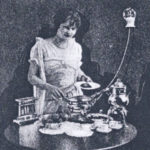In the early days of Australia convicts provided free labour, standards of living were generally poor and the small affluent society managed to live very well with a minimum of conveniences. Gradually the lower classes came to resent being servants.
There were two alternatives to the problem. One was to advertise overseas, mainly in Britain, for domestic servants; the other was to adopt the new-fangled Victorian gadgets that were supposed to make housework easier.
The first of the new wonders to affect the household was gas, first  introduced to Sydney in 1841 and praised in “The Australian” of 27th May, 1841: “The dim days of oil and tallow are gone by!” While only a few homes enjoyed the new delights of gas, people’s imaginations were fired by the potential of the scientific future. However methods of producing gas were poor and many people preferred the kerosene and pressure petrol lamps that were introduced from the 1860s.
introduced to Sydney in 1841 and praised in “The Australian” of 27th May, 1841: “The dim days of oil and tallow are gone by!” While only a few homes enjoyed the new delights of gas, people’s imaginations were fired by the potential of the scientific future. However methods of producing gas were poor and many people preferred the kerosene and pressure petrol lamps that were introduced from the 1860s.
 By the 1880s people were using the now more reliable gas for cooking and water heating. (They also had another brilliant new “appliance”, the water closet, which had been invented in this modern form by Thomas Crapper of Liverpool, England.) The use of gas continued to expand, and gas room heaters became available, but the real break through came with the invention of the gas heater wash boiler – the copper that reigned supreme in millions of laundries until the 1950s.
By the 1880s people were using the now more reliable gas for cooking and water heating. (They also had another brilliant new “appliance”, the water closet, which had been invented in this modern form by Thomas Crapper of Liverpool, England.) The use of gas continued to expand, and gas room heaters became available, but the real break through came with the invention of the gas heater wash boiler – the copper that reigned supreme in millions of laundries until the 1950s.
Australia was a pioneer in the use of electricity. Lamps were operating in Sydney in 1882 and the electrical revolution erupted, although Sydney was not to see its own full power station until July 1904, around a quarter of a century behind New South Wales country towns such as Young and Tamworth, and Melbourne, where it was instituted in October 1880.
It was in Melbourne that the wonders of electricity were first applied in the home. George Anderson, an Adelaide alderman, described the miracles he saw on a visit to Melbourne – electric fans, electric frypans, ovens and electric stew pans: “Ladies have an ornamental kettle and teapot stand in the drawing room now, and when afternoon tea is wanted, the ornamental wire attached to the kettle is inserted into a knob in the wall, and the kettle boils in a few minutes.”
By 1900 electricity was being applied everywhere, electric heating was popular and there were even electric cigar and pipe lighters. However, these were only for the wealthy and brave.
In the period 1900 to 1939, when World War II stopped all development, almost all the appliances we now accept without question were introduced and heavily advertised. This advertising completely changed the concept of home living as it offered an alternative to drudgery and dirt.
Refrigeration was one of the major advances. In 1878 Mort & Co had unveiled their ice-making machine and in 1912 the electric refrigerator came to Australia and Emmco Pty.Ltd. began mass production in 1927.
The hand-operated washing machine had been

introduced in the second half of the 1800s – and in fact in 1950 Breville were still advertising them for sale, mostly in country areas. The electric washing machine was first marketed in 1910, the vacuum cleaner in 1908 and the dishwasher in the 1920s.
By 1923 still only 34 per cent of homes were wired for electricity although it was available to half the homes of Australia.
Some electrical products achieved instant popularity. Of the homes with electricity around 75 per cent had electric irons, 20 per cent radiators and 7 per cent fans. Although toasters, kettles, sewing machines, stoves, clothes washers and dishwashers existed, less than 1 per cent of homes had them.
Even in the 1940s the average housewife still kept food in an ice chest, washed in a gas boiler and cooked on a gas stove, but more homes now had a vacuum cleaner, iron and electric radiator. Middle-class homes were lucky to have a single power point, any power for appliances coming from a double adapter plugged into a light socket.

Then came the post-war revolution. Email Ltd offered seventeen brands of refrigerators while Hallstrom offered a cheap-to-buy model. Refrigeration became an essential.
Hoover introduced their tiny but efficient agitator washer with hand wringer for £55, or about ten-weeks’ salary for the average person.
Papers were full of advertising. The “get rich quick” retailer put teams of door to door salesman on the road determined to put at least three appliances into every home.
The world of electronics opened up a whole new era of wonderful electric gadgets and today the average home runs about twenty electric motors – providing muscle power that has almost completely replaced the servant.
These photographs are just some items in our collection





